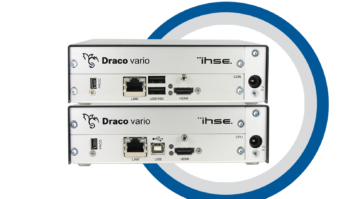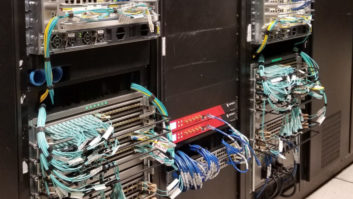Remote access: data cabling
May 1, 2002 12:00 PM, By Kevin McNamara, CNE
Here are some interesting statistics based on a research report issued by the Cahners In-Stat group in 2001:
- More than half of the workforce in the U.S. performs their jobs remotely, either occasionally or on a full-time basis.
- By 2005, the number of remote workers will increase to 60 percent.
- There are about 3 million remote offices currently. That number is expected to grow to 5 million by 2005.
- ISPs currently deliver services to more than 21 million telecommuters. By 2005, 35 million remote workers will require Internet access to connect with employers.
- U.S. businesses currently spend about $160 billion on communications services, which is expected to rise to nearly $260 billion by 2006.
While most of the aforementioned Internet access is expected to continue through the use of dial-in connections, the availability of broadband high-speed services, such as DSL and cable, is growing at a rapid rate and currently serves about 20 percent of the total Internet subscribers in the U.S.
Wiring these remote offices can be a simple task using off-the-shelf products; however, when a business permits workers to perform duties at a remote location, particularly their homes, it assumes a certain level of liability for the physical facility that houses the equipment, workers and others using the equipment at the remote location.

Table 1. Typical ratings and designations for low voltage cabling. Data courtesy of Berk-Tek.
Providing technical support to remote users is more difficult than simply going down the hall to troubleshoot a problem, sometimes requiring additional time on the telephone and possibly visits to the location.
Cabling options
In most cases, cabling a PC to a local LAN or high-speed network gateway will be done using standard Ethernet cabling. I have dealt with many of the electrical performance issues related to Ethernet cabling in this column; however, like all things electronic, performance increases and new emerging technologies begin to appear, so let’s take a quick look at the current state of transport methods.
Fundamentally, there are three transmission mediums that can be used for data transmission: electrical, optical and air. Each of these methods requires a specific component, which carries the signal from point A to point B.
Electrical
An electrical connection is the most familiar and popular transmission method. In the case of network cabling, we are usually referring to standard unshielded twisted pair (UTP) cable. Shielded twisted pair (STP) cable is similar to UTP, with the exception that the conductors are also surrounded by a braided shield. STP cable is used in areas where external sources of interference, such as high RF or electrical fields, might couple to the inner pairs and degrade performance.
Current versions of the Ethernet protocol over UTP supports data throughput of about 1Gb/s, and that is expected to increase to 10Gb/s in the next two years.
Optical
In the context of data communications, optical transmission medium generally refers to fiber optic cabling, where data is transmitted through thin strands of plastic or glass fiber material called the core, which is surrounded by a highly reflective material called the cladding. This assembly is covered with a protective outer jacket. The signals sent through fiber cabling originate from a laser light source, which operates at a specific wavelength.
An interesting fact is that fiber optic cabling has been around about twice as long as the standard UTP typically associated with the interconnection of devices on a LAN.
Air
Data transport through the air is possible using one of the many RF wireless options available for a variety of PC-to-LAN and LAN-to-LAN interconnections. The adoption of the 802.11x wireless Ethernet standard, along with the availability of spectrum specifically allocated for unlicensed RF applications, has created one of the fastest growing segments of the PC LAN market. The price point for consumer- and commercial-grade wireless devices is dropping to a point near that of similar wired equipment. Wireless LANs still lack the data throughput capabilities of their wired counterpart, typically limited to about 2Mb/s; however, emerging standards, improvements in technology and the allocation of new spectrum will ultimately make this the transport method of choice for most LAN designs. At least one manufacturer produces a line of point-to-point microwave radios that permits Ethernet throughput in excess of 100Mb/s.
A relatively new technology that uses high-powered, laser-based wireless radios is beginning widespread acceptance. These systems provide bandwidth nearly to that of fiber optic cabling and are limited only by the requirement that the radios have clear line-of-sight to each other.
Some cable-rating issues
In the U.S., the current National Electric Code (NEC) suggests that the installation of any permanent cable within commercial and residential buildings, including those that carry low voltage, have markings indicating the fire rating of the cable jacket. The NEC provides guidance in the installation of electrical systems based on its own testing, and it is generally the reference used by most electrical code officials.
There are various materials used in the manufacture of metallic and fiber-based cabling. In the case of a building fire, most of those materials were capable of supporting and carrying flames across several rooms or, in many cases, vertically through other floors.
The jackets of cables are manufactured with different materials based on the type of location (wall, inside conduit), orientation of run (vertical or horizontal) and where it will be installed. Table 1 describes some typical ratings and designations for low-voltage cabling.
Even flame-retardant cabling is capable of supporting a flame under the right conditions. To prevent those flames from moving into other rooms or floors, it is important, and required by code, to apply proper fire-stopping materials to walls and floors that have been penetrated by cables.
McNamara, BE Radio’s consultant on computer technology, is president of Applied Wireless Inc., New Market, MD.
All of the Networks articles have been approved by the SBE Certification Committee as suitable study material that may assist your preparation for the SBE Certified Broadcast Networking Technologist exam. Contact the SBE at (317) 846-9000 or go towww.sbe.orgfor more information on SBE Certification.






